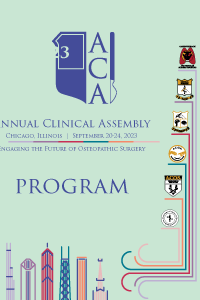General Surgery
Anti-NMDA Receptor Encephalitis Associated with Ovarian Teratoma: A Case Report
- IF
Ingy Farag, B.S
Midwestern University CCOM
Chicago, Illinois, United States
Primary Presenter(s)
Anti-N-methyl-D-aspartate receptor (NMDAR) encephalitis is a rare autoimmune disorder with neuropsychiatric symptoms that predominantly affects women. 50% of women with Anti-NMDAR encephalitis over the age of 18 have an underlying tumor that is typically an ovarian teratoma. Ovarian teratomas are mostly benign germ cell tumors that can recur in 4% of patients and can produce antibodies against NMDA receptors in the central nervous system. In this disease, neural tissue in teratomas release antigens that result in the production of inhibitory antibodies against the anti-NMDA receptor. This results in an increase in dopamine release, giving the characteristic psychosis symptoms. There are four phases of the disease: viral prodrome; neuropsychiatric symptoms including hallucinations and agitation; neurological complications including seizures; and prolonged deficits including executive dysfunction. It is important to have high suspicion for this disease upon early onset as anti-NMDAR encephalitis has excellent prognosis with 75% of people having full recovery or mild deficits with early intervention. A 25 year old healthy female with a history of prior bilateral ovarian teratoma cystectomy presented to the emergency department with short-term amnesia, bradykinesia, catatonia and altered mental status. She required inpatient hospitalization with sedation for combative behavior attributed to a psychiatric cause. Due to poor response, she was transferred to the medical floor and underwent extensive encephalopathy work-up. After 2 weeks, she was discharged from the hospital in wheelchair-bound status. She returned to the emergency department for fluctuating mental status, generalized tonic-clonic seizure, and episodes of drooling, staring, and catatonia. She continued to have sporadic seizures and psychosis episodes in the neuro-intensive care unit. Cerebrospinal fluid positive for anti-NMDA receptor antibodies confirmed the diagnosis. Ultrasonography and CT scan of abdomen and pelvis revealed recurrence of left ovarian teratoma. She underwent laparoscopic left salpingo-oophorectomy and received steroids, keppra, and 6 cycles of plasmapheresis. She was discharged after 4 days in complete recovery and maintained on oral steroids without needing anti-epileptic or psychiatric medications. First line treatment for anti-NMDAR encephalitis is tumor resection followed by steroids, IVIG, or plasma exchange. If there is no underlying tumor, rituximab or cyclophosphamide can be used followed by immunosuppression for 1 year and screening for ovarian teratomas for 2 years. Anti-NMDAR encephalitis associated with ovarian teratoma is a recently discovered disease in 2007 with little over 700 case reports that warrant further gynecologic research and increased public awareness, as outcomes could be catastrophic if not treated early. This case highlights the importance of early consideration of medical causes of new onset psychosis to avoid misdiagnosis and delayed treatment especially in young female patients with ovarian findings. Anti-NMDAR encephalitis should be suspected in patients with rapid onset of psychiatric dysfunction, movement disorders, seizures, and decreased level of consciousness.
Methods or Case Description:
Outcomes:
Conclusion:

